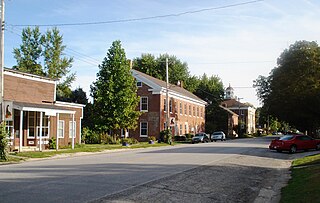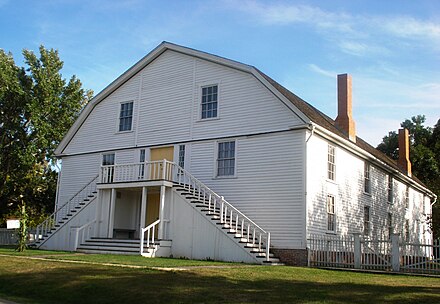
New Sweden was a Swedish colony along the lower reaches of the Delaware River in America from 1638 to 1655, established during the Thirty Years' War when Sweden was a great military power. New Sweden was part of Swedish colonization efforts in the Americas. Settlements were established on both sides of the Delaware Valley in the region of Delaware, New Jersey, and Pennsylvania, often in places where Swedish traders had been visiting since about 1610. Fort Christina in Wilmington, Delaware was the first settlement, named after the reigning Swedish monarch. The settlers were Swedes, Finns, and a number of Dutch. New Sweden was conquered by the Dutch Republic in 1655 during the Second Northern War and incorporated into the Dutch colony of New Netherland.

Cambridge is a village in Henry County, Illinois, United States. The population was 2,160 at the 2010 census, down from 2,180 in 2000. It is the county seat of Henry County.

Warren is a village in Jo Daviess County, Illinois, United States. The population was 1,428 at the 2010 census, down from 1,496 at the 2000 census.

Swedish Americans are Americans of at least partial Swedish ancestry. They primarily include the 1.2 million Swedish immigrants during 1885–1915 and their descendants. They formed tight-knit communities, primarily in the American Midwest, and intermarried with other Swedish-Americans. Most were Lutheran Christians with origins in the state Church of Sweden who were affiliated with predecessor bodies of what are now the Evangelical Lutheran Church in America (ELCA) from the mergers of 1988 or the Lutheran Church–Missouri Synod (1847), or the recent North American Lutheran Church (NALC) of 2010; some were Methodists following Wesleyan doctrine.

Jubilee College State Park is an Illinois state park located 6 miles west of Peoria, Illinois. It contains Jubilee College State Historic Site, a frontier Illinois college active from 1840 to 1862.
The Illinois Historic Preservation Division, formerly Illinois Historic Preservation Agency, is a governmental agency of the U.S. state of Illinois, and is a division of the Illinois Department of Natural Resources. It is tasked with the duty of maintaining State-owned historic sites, and maximizing their educational and recreational value to visitors or on-line users. In addition, it manages the process for applications within the state for additions to the National Register of Historic Places.

Dearfield is a ghost town and a historically black majority settlement in Weld County, Colorado, United States. It is 30 miles (48 km) east of Greeley. The town was formed by Oliver Toussaint Jackson, who desired to create a colony for African Americans. In 1910, Jackson, a successful businessman from Boulder, filed on the homestead that later became the town and began to advertise for "colonists." The name Dearfield was suggested by one of the town's citizens, Dr. J.H.P. Westbrook, who was from Denver. The word dear was chosen as the foundation for the town's name due to the precious value of the land and community to the town's settlers.

A round barn is a historic barn design that could be octagonal, polygonal, or circular in plan. Though round barns were not as popular as some other barn designs, their unique shape makes them noticeable. The years from 1880–1920 represent the height of round barn construction. Round barn construction in the United States can be divided into two overlapping eras. The first, the octagonal era, spanned from 1850–1900. The second, the true circular era, spanned from 1889–1936. The overlap meant that round barns of both types, polygonal and circular, were built during the latter part of the nineteenth century. Numerous round barns in the United States are listed on the National Register of Historic Places.
Eric or Erik Jansson or Janson was the leader of a Swedish pietist sect that emigrated to the United States in 1846.

Pullman National Monument, also known as The Pullman District and Pullman Historic District, is located in Chicago and was the first model, planned industrial community in the United States. The district had its origins in the manufacturing plans and organization of the Pullman Company, and became one of the most famous company towns in the United States, as well as the scene of the violent 1894 Pullman strike. It was built for George Pullman as a place to produce the famous Pullman sleeping cars.

During the Swedish emigration to the United States in the 19th and early 20th centuries, about 1.3 million Swedes left Sweden for the United States of America. While the land of the U.S. frontier was a magnet for the rural poor all over Europe, some factors encouraged Swedish emigration in particular. The religious repression practiced by the Swedish Lutheran State Church was widely resented, as was the social conservatism and class snobbery of the Swedish monarchy. Population growth and crop failures made conditions in the Swedish countryside increasingly bleak. By contrast, reports from early Swedish emigrants painted the American Midwest as an earthly paradise, and praised American religious and political freedom and undreamed-of opportunities to better one's condition.

The Nachusa House is a former hotel building in Dixon, Illinois, United States along Galena Avenue. The building was constructed in 1853 and operated continuously as a hotel until 1988. It underwent many alterations during the time it operated as a hotel. Following its period as a hotel the five-story mansard roofed building fell into disrepair and was nearly demolished in 1997. The building was restored by the Illinois Housing Development Authority and a Chicago developer at a cost of US$3.2 million and renovated into affordable housing for senior citizens. During its height the Nachusa House was a popular stop along rail and stagecoach lines and was a known layover for Abraham Lincoln. The Nachusa House was added to the U.S. National Register of Historic Places in 1983.

Apple River Fort, today known as the Apple River Fort State Historic Site, was one of many frontier forts hastily completed by settlers in northern Illinois and southern Wisconsin following the onset of the 1832 Black Hawk War. Located in present-day Elizabeth, Illinois, United States, the fort at the Apple River settlement was built in less than a week. It was one of the few forts attacked during the war and the only one attacked by a band led by Black Hawk himself. At the Battle of Apple River Fort, a firefight of about an hour ensued, with Black Hawk's forces eventually withdrawing. The fort suffered one militia man killed in action, and another wounded. After the war, the fort stood until 1847, being occupied by squatters before being sold to a private property owner who dismantled the building.

First State National Historical Park is a National Park Service unit which lies primarily in the state of Delaware but which extends partly into Pennsylvania in Chadds Ford. Initially created as First State National Monument by President Barack Obama under the Antiquities Act on March 25, 2013, the park was later redesignated as First State National Historical Park by Congress.
Clayville is a former roadside hamlet, inhabited from 1824 into the 1850s, located in Cartwright Township near Pleasant Plains, Illinois, United States. The settlement was never large but was firmly centered on a once-thriving tavern on the main road between Springfield, the state capital, and the Illinois River port of Beardstown. The Broadwell Tavern continues to stand on its original foundation today as a reminder of the once-active frontier settlement.

The Jenny Lind Chapel is a historic church located at the southwest corner of 6th and Oak Streets in Andover, Illinois. Completed in 1851 for a congregation founded the previous year, the church was the first built by the Augustana Synod, the main Swedish Lutheran church in America. Pastor Lars Paul Ebsjorn founded the church for local Swedes who still wished to worship with the Church of Sweden; many were former members of the nearby Bishop Hill Colony who had lost faith in Eric Jansson's teachings, while the others were Swedes who had immigrated to the area due to the colony's fame. The church was named in honor of Swedish opera singer Jenny Lind, who donated $1,500 for its construction. The building has a simple design with Greek Revival features, a common form for small rural churches of the era.

The Olof Johnson House is a historic house located at 408 NW 4th Street in Galva, Illinois. The house was built in 1863 for Olof Johnson, one of the trustees of the Bishop Hill Colony. In addition to his position within the colony, Johnson also played a significant role in Galva's founding and named the community after his birthplace of Gävle, Sweden. Johnson's house has an Italianate design, a popular style in the late 19th century. The house's wraparound front porch is supported by thin columns and features paired brackets along its roof; similar brackets can be found on the eaves of the house's cross gabled roof.























